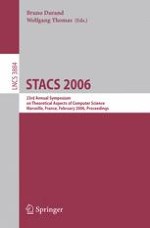2006 | Book
STACS 2006
23rd Annual Symposium on Theoretical Aspects of Computer Science, Marseille, France, February 23-25, 2006. Proceedings
Editors: Bruno Durand, Wolfgang Thomas
Publisher: Springer Berlin Heidelberg
Book Series : Lecture Notes in Computer Science
